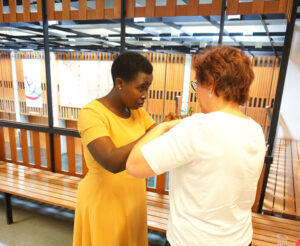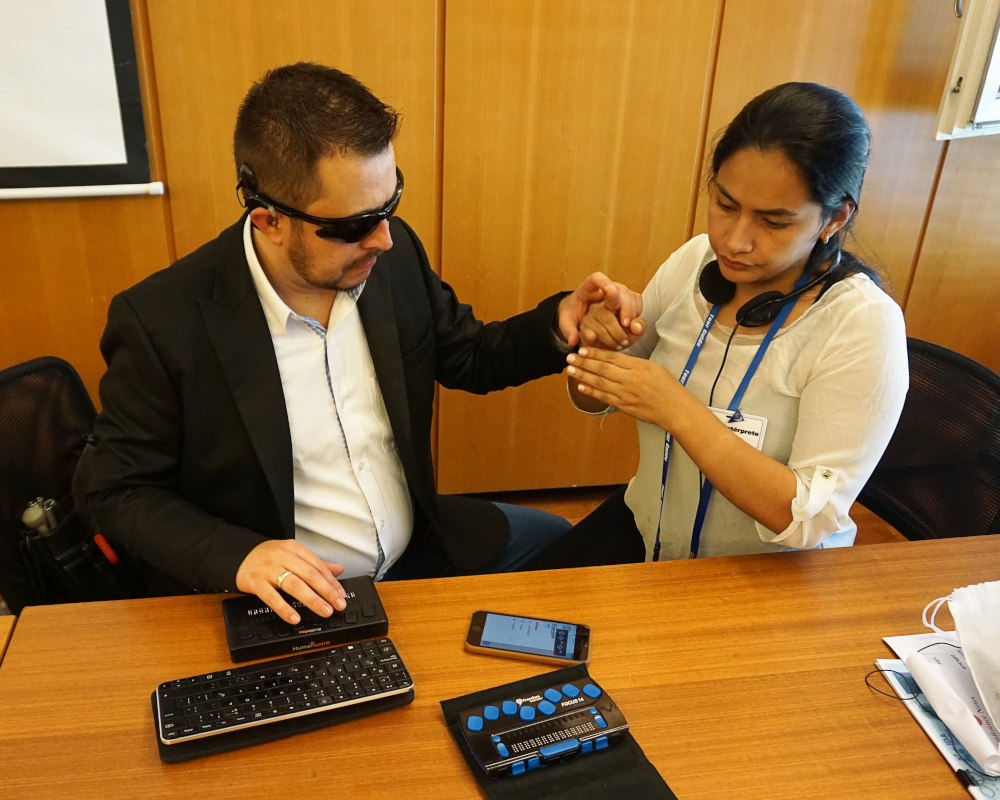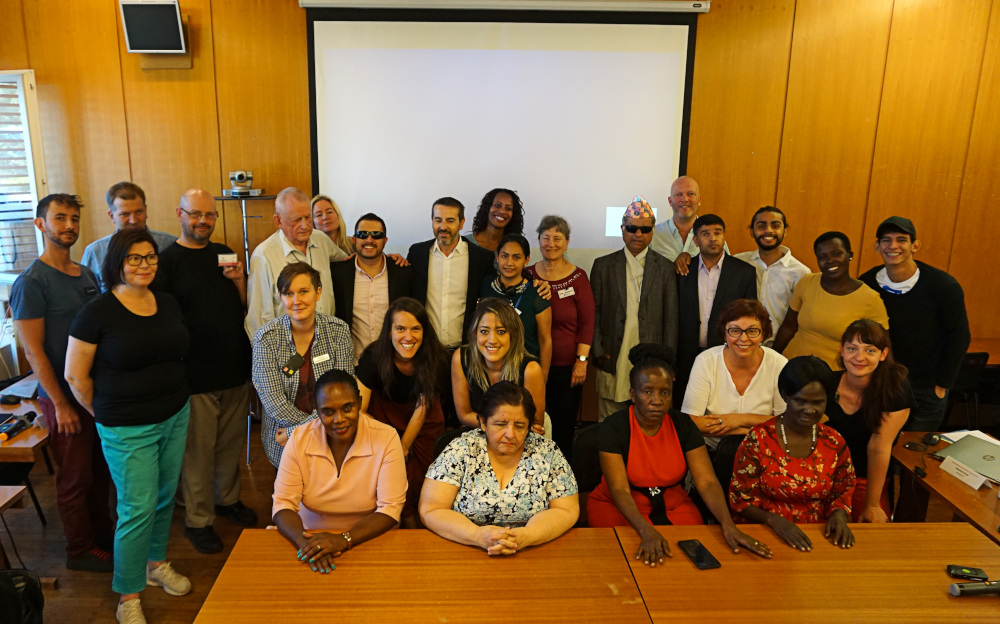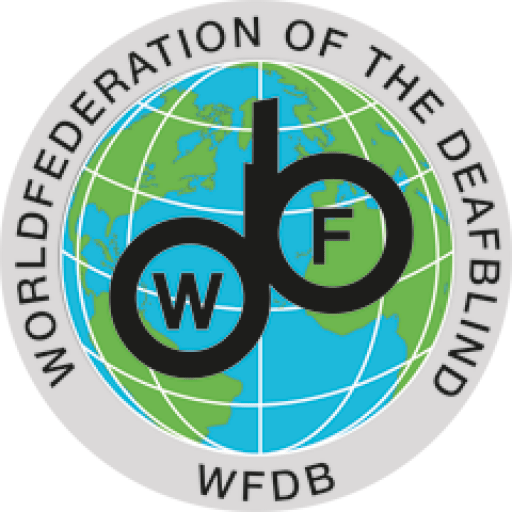WFDB’s 2nd technical SHAPES workshop was held in person in Geneva on 11-13 July 2022, to gather feedback and the perspective of persons with deafblindness. Find here the concept note.
WFDB is a consortium member of the SHAPES Project (Smart and Health Ageing through People Engaging in Supportive Systems), funded by the European Union which aims to improve the health, well-being, and independence of people as they get older.
The 2nd Technical Workshop included the participation of WFDB’s Executive Council (EC) and Regional Representatives, as well as the President, Francisco Trigueros (Spain) and Vice President, Sanja Tarczay (Croatia), of the European Deafblind Union (EDBU). One of its aims was to ensure proper knowledge of, and ownership of the ongoing work of SHAPES internally within WFDB, as well as strengthen ties with organisations of persons with deafblindness around the globe and SHAPES partners. You will find the workshop report here.

The workshop was an excellent opportunity to connect SHAPES with persons with deafblindness, as well as gather feedback and engage in discussions with this particular sample group. SHAPES partners and representatives were invited to the meeting and encouraged to make use of this unique opportunity to gather input and views on research being conducted, technological solutions, accessibility considerations, etc.
Moreover, discussions were held on the topic of the 2nd Global Report on the situation of persons with deafblindness currently being produced by WFDB and which will include a section on older persons with deafblindness. The workshop also provided a chance for WFDB representatives to share their work and priorities with other relevant stakeholders and strengthen ties with the International Disability Alliance (IDA) and facilitate exchanges with various UN agencies such as the World Health Organisation (WHO) and the Office of the United Nations High Commissioner for Human Rights (OHCHR).
Day 1 of the workshop
WFDB’s President, Geir Jensen, opened the workshop with welcome remarks, followed by the introduction from participants, which included 9 persons with deafblindness and their interpreter-guides from the following countries: Colombia, Ecuador, Nepal, Norway, Finland, Croatia, Spain and Uganda.
Lucia D’Arino, WFDB Program Advisor and focal point of the SHAPES project, gave a presentation on SHAPES and provided information on WFDB’s role in the SHAPES project, as well as updates and future activities. WFDB’s role in SHAPES is to bring the perspective of the deafblind community, coordinate and facilitate the participation of older persons with deafblindness across Europe into the project and contribute with the unique knowledge and understanding of deafblind people and their diverse needs, including through the production of more evidence and recommendations to improve inclusion of persons with deafblindness. More information on WFDB’s role in the project can be found here.
The following session was dedicated to consultation and feedback gathering from the representatives with deafblindness, who provided their perspective and an overview of their country or region on the following topics:
- The current situation, challenges and barriers faced by older persons with deafblindness
- Good practices and recommendations
- Physical accessibility of public areas and services
- Digital accessibility and the use of technology to improve quality of life
Amongst the different topics discussed, the importance of making technological devices accessible and affordable to persons with deafblindness was particularly raised. Participants had a chance to exchange information on technology which meets their needs and expectations, however, it was commented that many potentially useful technological solutions are targeted at persons who are blind, but not persons with deafblindness. Another point discussed regarding technology was the price, lack of adjustments, maintenance, and training in the use of assistive devices. In the countries and regions where such services exist, there are waiting times of several months at best. Being provided with assistive technology is not good enough if the recipient cannot use it properly due to a lack of adjustments or training. Platforms that allow information exchange between persons with deafblindness, as well as strong personal/professional networks were proposed as temporary solutions to overcome the barriers to acess technology and information.
A key remark was the importance of raising awareness of the diversity within the deafblind community, and the variety of needs. For example, some can use glasses or hearing loops, other can read braille, and some can utilise a screen reader. Many are e-literate and can use computers and smartphones, whilst others cannot due to, for example, poverty, lack of services in their region or age.
Moreover, participants reported a lack of disaggregated data and statistics on older persons with deafblindness. However, the SHAPES project has provided an excellent platform to collect data, especially qualitative on health, technology and barriers, as per Article 31 of the Convention on the Rights of Persons with Disabilities (CPRD).
The feedback collected will feed into the final project report to be published in 2023, which will focus solely on the situation of older persons with deafblindness. Moreover, in the 2nd global report on persons with deafblindness to be published at the end of 2022, the SHAPES project will be included as an example of a good practice on how to mainstream disability and deafblindness in a broader context.
Day 2 of the workshop
The second day included presentations from two SHAPES technical partners who presented their digital solutions. The first one is SciFY, which presented online their app called “I Can See” (currently only available for Android). It is originally aimed at persons with a visual impairment and allows them to see print or images such as menus and signs in different formats or sizes. Unfortunately, is it currently not available for IOS systems, and is only useful for those with residual vision. Further developments must include compatibility with braille lines and screen reader software.
The second one was the App named “Access Earth”, which provides a mapping and review database for persons with disabilities as it provides information on the accessibility of areas and businesses. The idea was appealing to participants, although the lack of language options and information in their area/region made it less useful at this point.

Participants and interpreter-guides who owned compatible personal devices were able to download these apps and provide information on its usefulness, accessibility, usability, etc.
Additional feedback was gathered from this sample group of persons with deafblindness on technology and recommendations. The main comment was to encourage all stakeholders to involve and consult different persons in the deafblind community and their representative organisations on developments and improvements related to technology, assistive device and artificial intelligence, in line with the motto “nothing about us without us”.
The afternoon sessions included the presentation from Rune Jensen, WFDB Policy Advisor, on the WFDB’s 2nd Global Report, to be published at the end of 2022, providing information on the latest updates and future steps. This was carried out in collaboration with the consultant working on the production of the report. Following feedback from participants, efforts will be made to ensure the perspective of the deafblind community is at the heart of the report, and that the drafting process is as transparent and inclusive as possible. Before publication, there will be a consultation among the WFDB members at the Helen Keller World Conference in the last quarter of 2022, as part of a validation process leading to the final report.
Day 3 of the workshop
The morning sessions included a presentation from Priscille Geiser, IDA Program Director who presented an overview of the work carried out by IDA with persons with deafblindness, including workshops, surveys, and fellowships. Priscille presented upcoming processes where priorities of persons with deafblindness need to be shared, such as the 2nd World Disability Report which is at its very initial phases. Participants expressed their desire to be involved in the development of the report and shared the priorities of the deafblind community, which include amongst others awareness raising on deafblindness as a distinct disability, the importance of interpreter-guides, etc. The 1st WFDB Global Report must be used as a cornerstone.
The afternoon sessions included meetings with UN bodies, in collaboration with Jarrod Clyne, IDA’s Human Rights Advisor, who provided an update on IDA’s work related to human rights and opportunities for persons with deafblindness to provide their input. Examples include a report from the UN Office of the High Commissioner for Human Rights (OHCHR) on community inclusion to be published in March 2023 and a resolution on the topic of rehabilitation in January 2023.
The participants first met with an OHCHR representative, Juan Sebastian Jaime Pardo, to discuss the importance of including the perspective of persons with deafblindness in human rights processes and activities. The representative encouraged the deafblind community to participate in areas that the UN is already working on, such as the reports currently in development. Persons with deafblindness have a lot to contribute and should therefore submit their papers in different UN processes.

The participants later met with representatives from the World Health Organisation (WHO) namely, Darryl Barrett, Technical Lead for Disability and Rehabilitation, Robert Jakob, Team leader for Classifications Terminologies and Standards and Alarcos Cieza, Unit Head on Sensory Functions, Disability and Rehabilitation. The urgency of adding deafblindness as a unique disability in WHO’s International Classification of Functioning, Disability and Health (ICF) was flagged by the participants. It was highlighted that there is a lack of specific services for persons with deafblindness because deafblindness is not classified as a unique and distinct disability by the WHO. Participants asked to have an equal place at the table with other disability groups, since, without the necessary classification and recognition, persons with deafblindness will still be left behind.
The representatives reassured the participants that WHO’s goodwill is already on the table, and steps will be taken to ensure the classification of deafblindness becomes a reality hopefully within a year. However, further follow-up and information exchanges are needed between the deafblind community and the WHO to accomplish this.
